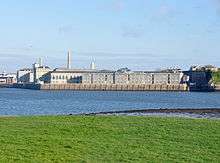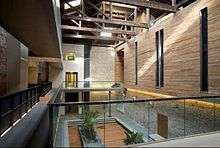Royal William Victualling Yard
.jpg)
The Royal William Victualling Yard in Stonehouse, a suburb of Plymouth, England, was the major victualling depot of the Royal Navy and an important adjunct of Devonport Dockyard. It was designed by the architect Sir John Rennie and was named after King William IV.[1] It was built between 1826 and 1835, and occupies a site of approximately 16 acres (65,000 m2) being half of Western Kings, north of Devil's Point.
The Yard was released from the MOD in 1992 and subsequently passed to the Plymouth Development Corporation, upon their demise in 1999 it then passed to The South West Regional Development Agency (SWRDA) who funded and carried out the extensive c£60m restoration of the structural fabric of the majority of principal buildings and infrastructure within the yard between 1999 and 2008. During this period the buildings were re categorised from Scheduled Ancient Monuments to Grade I / 11 listed structures. Private sector development partners Urban Splash were then engaged to carry out the specialist conversion of the site into to an up-market mixed-use development. Described as the grandest of the royal victualling yards, 'in its externally largely unaltered state it remains today one of the most magnificent industrial monuments in the country'.[1]
The site
Plymouth's old victualling yard, on a wharf next to the Citadel at Sutton Pool, predated the establishment of the dockyard at Devonport in 1690. Through the eighteenth century it continued in use, with manufacturing taking place at various locations around the old harbour. Following the Napoleonic Wars, it was resolved to centralise Plymouth's victualling provision on a new site. Over three years, the northern half of the promontory known as Western King was levelled to provide the site for the new yard, the spoil being used to extend the site, which was arranged around a deep basin lined with granite.[1]
The buildings
The Royal William Yard is a collection of Grade I and Grade II listed buildings, built from Devon limestone with granite detailing; these include (East to West):
- Clarence

Originally the first structure built on the site, Clarence is now an award-winning conversion comprising 52 contemporary apartments. This building was originally used as a liquid store with one floor each of spirits, vinegar and beer (use of iron for the roof, doors, windows etc. was to mitigate against the flammability of alcohol). As needs changed, so did the role of the Clarence Store, and latterly the building was used for the storage of spares and components.[2] Positioned at the opposite end of the yard to the gatehouse, the Clarence building closes the vista along the main thoroughfare.
- Brewhouse


The subject of an award-winning conversion, this building has 78 apartments, together with ground floor commercial space for exhibitions, cafés and restaurants. Although purpose built in 1834, it was never actually equipped as a brewhouse, since emerging technology allowed large quantities of fresh water to be carried at sea, thus eliminating the need for the beer rations. It stood empty until 1885, when the west wing was used as a repair workshop and rum store. In its history it has even housed a torpedo workshop for the Navy.
- Cooperage
Originally a combination of workshops, offices and storage/seasoning space (built around a pair of concentric quadrangles) accommodating 100 coopers to make the barrels and kegs in which the produce of the 'Yard' could be stored and transported. It was soon to become a monument to the march of technology: demand for the coopers' skills declined over time until only 12 were employed. In 1891 the coopers and other craftsmen based there were transferred to the New Cooperage (q.v.), to make way for the newly established Navy Ordnance Board. The Board transformed the Old Cooperage into a machine shop and ordnance store, and in 1916 the courtyards were roofed over.[3]
Quadrangular storehouse building, designed, built and operated as the nerve centre of the whole of the Royal William Yard. All administration was carried out here and it served as a major storehouse for food, clothing and equipment.[4] As of 2014 it was scheduled to be converted into a hotel.[5] The central cupola contains the yard's original (and still functioning) quarter-chiming clock of 1831 by Benjamin Lewis Vulliamy.[6]
- New Cooperage
Sixty years after the Yard was completed, the New Cooperage was built to house the coopers and others tradesmen displaced by the rearrangements, including the arrival of workshops. Here there was room for painters, wheelwrighters and a host of other skilled men needed to keep the Royal Navy in perfect trim. Its final use was a survival pack ration and equipment store.
- Mills Bakery
Now including 86 apartments, commercial and office space, it was originally equipped as a biscuit and bread factory in 1834. Given only one full production run, there was no more baking here until 1847 when, newly equipped, it was used for its original purpose until 1925, subsequently becoming a clothing and equipment store.
- Slaughterhouse

Up to 100 bullocks per day were slaughtered here and the meat salted into wooden barrels. The building was in use for this purpose for 26 years from 1859. Most recently, the Slaughterhouse has been used as a centre for building repair and maintenance.
- Main Gate
The granite 'triumphal arch' gateway is topped by a 13-foot statue of King William IV (the Yard's namesake). It also displays the crossed anchor device of the Victualling Commissioners.[7]
- The Guardhouse

Now restored and occupied as a small office space
- Residences 1 and 2
These two grand houses were built for civil service officers in the Royal William Yard and were continuously occupied as homes until shortly after Plymouth Development Corporation took over ownership. Currently utilised as office space.[8]
Restoration and conversion

Early conservation and restoration work was carried out by Gilmore Hankey Kirke Architects. Together with Acanthus Ferguson Mann Architects they were awarded by the RIBA in the South West region for the Clarence and Brewhouse buildings. The scheme is also a winner of a RIBA 2006 Conservation Awards, which recognise best practice in the field of building conservation. Continued restoration, conservation and conversion of these Georgian Buildings has been carried out by Urban Splash with Gillespie Yunnie Architects. The site is open to the public and offers the 'Tunnel to Firestone Bay' a public basin for visiting boats and restaurants, cafés and public events.
Coordinates: 50°21′42.12″N 4°09′53.1″W / 50.3617000°N 4.164750°W
References
- 1 2 3 Coad, Jonathan (2013). Support for the Fleet. Swindon: English Heritage.
- ↑ Listed building description
- ↑ Listing text
- ↑ Listed building description
- ↑ BBC news report
- ↑ Clock from the past
- ↑ Listed building description
- ↑ Historic England. "House No 1 (Grade II*) (1378538)". National Heritage List for England. Retrieved 29 June 2014., Historic England. "House No 2 (Grade II*) (1378539)". National Heritage List for England. Retrieved 29 June 2014.
External links
- Royal William Yard
- Urban Splash
- Royal William Victualling Yard – The Encyclopaedia of Plymouth History
